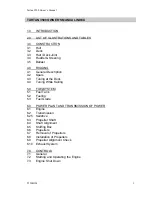
1-18
170 Montauk
Section 1• Safety
R
Excessive Noise
Many areas regulate noise limits. Even if there are no
laws, courtesy demands that boats operate quietly.
Wake / Wash
Power boat wakes can endanger people and vessels.
Each power boat operator is responsible for injury
or damage caused by the boat’s wake. Be especially
careful in confined areas such as channels or marinas.
Observe “no wake” warnings.
SPEED HAZARD - Watch your wake. It might
capsize a smaller craft. You are responsible
for damage caused by your wake.
!
WARNING
Reduce speed in congested waterway. Be
alert for No Wake markers.
!
WARNING
Mounted at key locations throughout the boat (See
figure 1.19.1), warning labels advise the owner/
operator of imperative safety precautions to follow
when operating and/or servicing equipment.
DO NOT REMOVE OR OBSTRUCT ANY
WARNING LABEL.
Replace any label which
becomes illegible.
Warning Label Locations
Recreational boaters have a role in keeping our
waterways safe and secure. Violators of the
restrictions below can expect a quick and severe
response.
•
DO NOT
approach within 100 yards, and slow
to minimum speed within 500 yards of any
U.S. Naval vessel. If you need to pass within
100 yards of a U.S. Naval vessel for safe
passage, you must contact the U.S. Naval
vessel or the Coast Guard escort vessel on
VHF-FM channel 16.
America’s Waterway Watch
In March, 2005, the U.S. Coast Guard officially
launched
America’s Waterway Watch
to encourage
the boating public to report suspicious activities
in our nation’s ports and waterways. A
merica’s
Waterway Watch
simply asks anyone who works,
lives, or recreates on the water to keep an eye out for
suspicious activities. Anyone who spots such activity
is asked to call the National Response Center’s
24-hour hot line, 800-424-8802 or 877-24WATCH
(877-249-2824).
DO NOT approach within 100 yards of any U.S.
Naval vessel without first contacting the vessel
on VHF-FM channel 16. To do so will result in a
quick and severe response.
!
DANGER
Homeland Security restrictions
• Observe and avoid all security zones. Avoid
commercial port areas, especially those that
involve military, cruise line or petroleum
facilities. Observe and avoid other restricted
areas near dams, power plants, etc.
•
DO NOT
stop or anchor beneath bridges or in
channels.
Summary of Contents for 170 Montauk
Page 1: ......
Page 43: ...1 22 170 Montauk Section 1 Safety R THIS PAGE INTENTIONALLY LEFT BLANK ...
Page 67: ...2 24 170 Montauk Section 2 General Information R THIS PAGE INTENTIONALLY LEFT BLANK ...
Page 91: ...4 12 170 Montauk Section 4 Electrical System R THIS PAGE INTENTIONALLY LEFT BLANK ...
Page 102: ...5 11 Section 5 Care Maintenance R 170 Montauk Reinforcement Location Diagram ...
















































